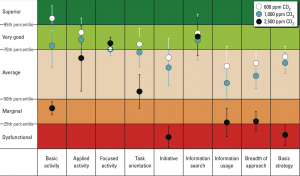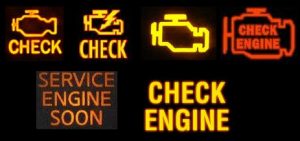Indoor air quality has a potentially significant impact on both ‘health’ and ‘learning.’ Building codes address ‘health’ – but not ‘learning’. In this article we will discuss its impact on learning. The sources of all facts used can be found in the Bibliography.
Scientific research has now shown that it is entirely possible that a schools indoor air quality can lower students performance one or two letter grades, and still meet all the legal requirements for a “healthy” building.
(In addition to learning issues, there are three main health risks. We do not discuss those in this article. To learn more in depth about them, go back to the Home page, and from among the boxes at the bottom select the menus having to do with Asthma, Radon, or Lead in drinking water. There you will find in-depth articles, bibliography, and a list of tools and ways you can investigate them.)
A key fact to understand is that once a building is constructed, with few exceptions there are no requirements that it be modified up to new standards. If it was built to allow the windows to open, but because of efforts to save money, or prevent intruders they have now been sealed shut, indoor air quality suffers – legally.
The air inside a classroom can have dozens of ingredients, contributed to by cleaning products, classroom experiments, outside air pollution pumped into the room, and many other sources. Testing for all those ingredients is complicated and costly.
The source of all indoor air quality regulation is The American Society of Heating, Refrigeration, and Air-Conditioning Engineers, or ASHRAE. This organization is the leading professional society in the world dealing with controlling indoor air and setting the standards that buildings are supposed to be built and operate under. They also make recommendations, which are not standards, and are not binding on local officials.
You can buy a complete set of the latest standards and recommendations, published in 2016, here.
But these standards and recommendation have nothing to do with ‘learning,’ or how the brain functions at different levels of oxygen or other ingredients in the air.
CO2 is created in a building when people inhale oxygen rich air, use up the oxygen, and exhale CO2. So crowded spaces or spaces with poor systems to bring in more oxygen rich air from outside can have high and rising levels of CO2 – which makes the brain work less well.
In the following graph, look at how our brains work in 9 different categories of mental functioning (look below the columns for the kind of mental activity being measured), under 3 different levels of ‘healthy’ air. Notice the dramatic difference in brain function between the white circles at 600 ppm of CO2 and the black circles at 2,500 ppm of CO2.

ASHRAE actually recommends that CO2 levels be held to 1,000 ppm. Unfortunately, it is not a legally binding standard – it is only a recommendation – and because of their age, most school buildings were not built to meet it. See page 35 here:
Why do building designers and builders measure CO2 at all?
